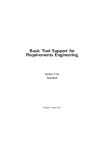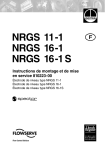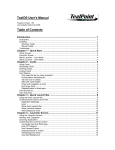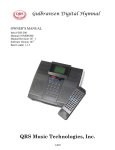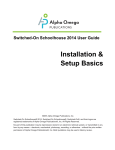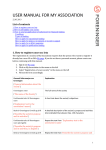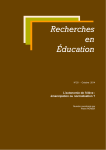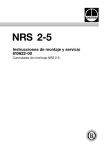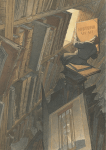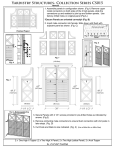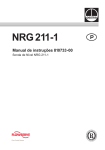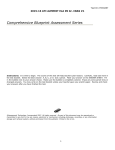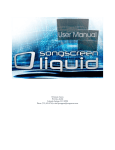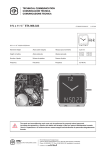Download Quentel Series featured
Transcript
Stories from the world of innovation, design, typesetting, research and development 2K/STORIES ISSUE 1 / 2014 EUR 2.50 ISBN 978-87-7081-050-0 hot metal: the history of typesetting Schuyler quentel nasb editions introducing Bibleon norwegian Bible 2011 conversion, automation and verification We do not suggest change just for the sake of changing editorial leader by Klaus E. Krogh Our great ambition is to design Bibles and Hymnals and related products: – As appealing as possible, also to new readers, – With the utmost readability, for all age groups – In the very best quality, within a given budget All for the purpose of: more people, buying more Bibles and spending more time in the company of the message of the text. To achieve this, we sometimes present our customers, the most esteemed bible publishers in the world, with new solutions to old problems. After all, the rules in the graphic industry have been developed over the last 500 years or more, and are constantly changing. As a postgraduate I made sure I learned all the rules, thinking that it would allow me to think about design as aesthetics only. Now I know that it is not enough to know all the rules, you also need to know the problems that the rules are there to solve. Looking at the problems, you often realise that possibilities of solving these today are different to what Johannes Gensfleisch zur Laden zum Gutenberg (ca. 1400 – 1468), John Baskerville (1706–1775) or Giambattista Bodoni (1740–1813) had at hand. We have to rethink the solutions, addressing the same problems. Just like the very best professionals have always done, to be able to design and produce the very best Bibles, again and again. Solutions that mirror the style trends of our period and bring forth the very best in the Bible tradition, that will help us to create the very best Bibles that todays technology will allow us. This is our obligation: Having the rewarding task of being a part of the distribution of the oldest but still the very best news. So when we suggests changes to a Bible design, we do that to fulfil our obligation. But at the same time we try to do it: – In recognition of the work of the great masters before us. – In admiration for the great work translators and editors have done making the translation ready – With respect for the expectations of the audience that have felt at home using the previous editions. Meanwhile, we, the employees at 2K/Denmark, believe in: · Creative collaboration · Striving for quality · Having the courage to challenge limitations With the great ambition to: · Create interfaces · Enhance user interaction and experience In analog and digital communication And, together with our customers to: · Develop functional and readable and aesthetic, award winning books and apps. Let this be an open invitation. I hope that you will enjoy this magazine, and we would love to hear from you with remarks, questions and even requests for topics to be presented in the next issue. Yours sincerely, Klaus E. Krogh [email protected] tel +45 8740 8000 / +45 2069 9911 2K/STORIES / Issue 1/2014 / isbn 978-87-7081-050-0 / Publisher: Forlaget SAXO, Denmark / Circulation: 1000 worldwide / Printed by: EJ Graphic, Beder / Design and dtp: 2K/DENMARK / Publisher and Editor in chief: Klaus E. Krogh / Editor: Katrine Jonassen / Contributing Editor, art direction, cover illustration, photography: Andreas Krautwald / Subscriptions: [email protected] / printed on 170 gsm Profi matt / profi silk / profi gloss. Printed in denmark 2014. www.2kdenmark.com Designers column What to do when all you have is a blank page and some questions, how not to settle for less when reality comes calling, and why it’s important to call things by their proper names. opinion by andreas krautwald Question everything How do you handle that big, metaphorically blank page that is working with design? From my chair, it comes down to being in a constant state of questioning everything. I don’t want to sound like I’m needlessly critical, so I shall attempt to justify my reasoning, and, to paraphrase Hunter S. Thompson, “I hate to advocate scepticism, critical thinking or uncertainty to anyone, but they’ve always worked for me”. Design is about solving problems, and questioning everything is a means to actively define the problems you have to solve. It can be as general as asking yourself or your team: “what is the problem we are trying to solve with this project” or as specific as: “why should this paragraph have an indent?”. The process resembles the “5 Whys” technique of examining cause and effect. If every choice in your design process is informed by logical cause and effect, the end result will be internally consistent. We work from the top down when we define a project. “Who are we talking to”, “what are we trying to say” and “how do we want to say it”. When it comes time to implement, we work bottom up, and use chains of questions to ensure that the tiniest details reinforce the greater goal of the design. This is famously how Mazda designed the MX-5 in 1989. The end goal was defined as “Jinba ittai” (人馬一体, person and horse as one body, a term appropriated from Yabusame, Japanese mounted archery), and the designers used Ishikawa diagrams for cause and effect analysis to ensure that every design choice worked towards that goal. Soft values, hard circumstances Much of the work at 2K/DENMARK involves handling massive amounts of often quite complicated text. Harsh reality tends to put some demands of practicality on our work, irrespective of the many wonderful qualities that we are looking to express. While there are certainly times when all those charac- ters just. won’t. fit. on the page, there are also times where we can turn the restrictions to our advantage. There’s a lovely feeling of certainty when circumstances dictate “this solution is the way it is because it must be so”. The challenge then becomes to inject expression and delight into pragmatic designs. Since we are operating under practical constraints, the expression must come through typographical attention to detail and subtle use of space. Complicated content not only forces space-constrained design solutions, it also requires systematic handling of the text and carefully considered formatting and conversion processes. Again this can be a blessing in disguise. When you need a fully developed mark-up schema to handle your content, all the typographic nooks and crannies become apparent. By going through every element in your mark-up from end to end, you can apply the Ishikawa-style, questioning approach and optimise every little <element></element> to reflect and support the soft values you are trying to impart. Language affects thinking For any craft, the terminology that develops along side the craft itself, has a profound effect on the way craftsmen discuss and think about our subject. In Denmark our terminology has germanic origins. The Anglophone “em-space” in Danish is the delightfully Teutonic “Geviert” [ɡəˈfiːɐ̯t] – and while the emspace and its nickname “mutton” summons up the shape of an “m” and a lovely lambchop, a Geviert is much more geometricaly evocative, it’s literally squared off. It’s a term that affects how you think about and use the tool. A mutton is a soft and rather vague piece of whitespace to be inserted between words and seasoned to taste. A Geviert is a grid-quadrant, it demands precision, order and structure, it forms the basis for whole systems of indentations, margins and gutters. “A Geviert of the leading” is my reflexive answer to any question involving whitespace and text. I find it very rewarding to step back and think about the terms of your trade and how they affect your thinking – and, because we are dealing with language here, how they affect your communication. True names, after all, have power, and like our lowly square piece of white-space, ideas are affected by terminology. Schuyler Quentel Reference Bible NASB – Reflections on the groundbreaking design of one of the premier luxury bibles on the market today By Andreas Krautwald Requirements In the spring of 2013, Schuyler approached 2K/DENMARK with considerations for a new line of luxury editions. We were supplied with a list of values to be expressed in the design: Legibility, Attention to Detail, Elegance, Clarity and Beauty. These were not to be small, thinline or portable bibles, but full on, luxurious reading editions. It's a pleasure to be given such a task, an opportunity to flex some typographic muscles. The standout qualities are Elegance and Beauty. Legibility and Clarity is key to every bible we design, but it's rare that economy and small size gives way to beauty. Formal requirements from Schuyler were: – 1500 - 1600 pages – 6" x 9" Trim Size – 1.5 cm margins – serif typeface – two colour text – high legibility – paragraph headings – italics for inserted text –references and notes separated from the bible text –footnote and cross reference callers should visually distinct – verse numbers should be prominent – running headers with chapter numbers – Hebrew characters in the acrostic poems ➌Cross references are called out with alphabetical markers, and footnotes with numerals. Both systems reset each page. The references are grouped and preceded by their chapter-verse, which disambiguates references in case the numbering resets to “a” on a page. General design considerations ➋Cross references take up a lot of space, which decreases elegance and increases page count. ➌Cross reference- and footnote callers need to be visually distinct. – The NASB was typeset as a red letter version, substituting for black letter before going to press. In this way, a potential later red letter version can be output from the same set of files, and there is only one set of files to keep current. For a red letter edition, the secondary colour would not be used for the chapter numbers. –Many typefaces were considered for this design and a lot of standard workhorse typefaces were discarded in favour of the luxurious beauty of Milo Serif from American type designer Michael Abbink. Milo Serif has the added advantage of combining well with the Milo sans serif companion typeface, that we are using for non scripture materials. We are very happy with the performance of this type family in these editions. Solutions Finesse and innovation ➊Running headers printed in secondary colour to separate them from subheadings ➋ – Use short names of books in cross references. – Run on individual cross references, separated by white space. –Set in sans serif; decreases optical weight of cross references and saves space. –Only indicate referred chapter-verse number once, in bold for easy reference. –Set with less leading than the bible text. It was clear that the large amount of cross references were going to impact the elegance of the page. We needed to typeset the cross references very space efficiently but also make the pages look elegant and clearly separate the cross references and notes from the bible text. We came up with the idea of treating footnotes and cross references as a single element, tied together by a red hairline. Our normal approach is to lock every element to the baseline grid to ensure line on line printing, so in this case we've kept everything locked around the space of the hairline separator. That way there is a No expense is spared when finishing out the Schuyler Quentel bible line. The best paper, the best print and truly luxurious book binding with real goatskin and 4 reading ribbons. Challenges The NASB translation is medium length at 4,200,000 characters, 23.6 words pr. sentence, paragraphed with subheadings and with a large amount of cross references, footnotes and poetic text. As such, it does not pose any extraordinary challenges to the design – apart from the number of cross references and footnotes (up to 100 on a page!). We identified the following issues that needed special attention in these editions: ➊Running headers tend to clash with subheadings when they appear at the top of columns. abde 4 The table of content has been layed out to reflect the structure of the bible. The scripture content is grouped by testament and is typeset in Milo Serif to echo the design of the actual text. Both long and short names of the books are listed as an explanation of the abbreviations. The non scripture materials are listed before and after the testaments in the sans serif Milo typeface, and indented to clearly separate it as additional content. Preliminary pages are numbered with roman numerals, so that page 1 starts on the half title page of genesis. The map section is printed in the rear endpapers, and as such are not numbered. clear rhythm to the whitespace around it. The footnotes are anchored to the hairline from the bottom and grow upwards from there, so they form an element with hairline and cross references. The innovation is in how the cross references are allowed to grow. They are locked by their top to the hairline and grow downwards from there. We then define a minimum and a maximum lower page margin and when the footnotes exceed the maximum, the whole system of footnotes, hairline and cross references are moved up by one unit of the baseline grid. So for the first time we have a system where we can prioritize white space on the page when the amount of cross references allow it, or a maximum efficiency setting of the cross references when needed, all of which gives way to the larger priority of spacious and elegant bible text. This is a truly groundbreaking setup and one that wouldn't be possible without the coding prowess of the 2K/DEVELOPMENT team. While the cross references are spanned across both columns at the bottom of a page in a nice taper, the footnotes are kept in the outside column, creating symmetry across a spread, gathering the scripture text towards the centre of the spread. We believe it helps readability and makes for a cleaner and more attractive page if we can use whitespace and extras to gather rather than fracture the arrangement of elements on the page. In renaissance book printing it was customary to taper the bottom of the column on exit-pages. We have echoed this tradition on our exit-pages, by moving the footnotes/ cross references up below the end of the scripture text, finishing out the page nicely as well as reinforcing the concept of the fluid bottom margin. The footnotes span both columns on exit-pages to create symmetry on the single page, mirroring the renaissance ideal. It's important for us to always carry through design concepts in as many areas as possible. We believe this helps create a unified whole, when the reader can recognize subtle design principles throughout the bible. It's the same principle at work when we use serif typefaces to signify scripture text throughout the bible. The front endpapers are printed as presentation pages with an Arts and Crafts style vignette, to reinforce the hand-crafted, luxurious feel of the book-block and binding style. These editions are furnished with a full map section from Oxford Cartographers – arguably the finest maps available. We have worked together with Oxford Cartopgraphers to integrate the map signature in this design, including creating a new typesetting of the map index in the design of the interior pages as well as laying out a page template to fit the maps into. Conclusion We would like to thank Schuyler for the opportunity to meet the challenges of the Quentel luxury editions. The special considerations of the cross reference/footnote system pushed our Design team to come up with innovative solutions that again challenged the development team to develop new automation techniques. Working on this project has given us new tools and techniques, and given Schuyler a new line of luxury editions. It's a process we are very proud to have been part of. 5 abde the interplay of technology and arts From prehistoric times to the digital age, writing is the dominant media for global scholarly collaboration and the acquisition and preservation of knowledge. We use writing to connect, complain, inform, make official, to exclaim, remember, mail, tweet, or to write on each other’s walls. Traditionally, the role of typography is to organize the temporal-spatial or visual and geometrical properties of text. Without typography, any written scribble remains essentially unreadable. Thus, typography constitutes writing and is not mere beautification or decoration. Ever since Gutenberg, the multitudes of expression in type and the richness of the typographic tradition has grown steadily with technological development. For the same extent of time, the bible has been the foremost example of how we pass on information to the next generations, using the very best technology available to us. The high ambitions of this work necessitates ceaseless development of the craftsmanship, and we find ourselves forever asking: What does this particular technology have to offer to our typography? By katrine jonassen & Andreas KRautwald Combining all the typographic workflows into one magnificent mechanism, is an ingenious achievement. Not for nothing did Thomas Edison call the Linotype the “Eighth Wonder of the World”. Having seen one in use, one can’t help but notice the mesmerizing musical qualities of its rhythmic clicking, clanking, whirring, humming, tapping – a symphony of functionality and industry. In the 1970’s, the breakthrough of the ball head printer made printing affordable to the masses, democratizing communication and the transfer of knowledge on a whole new level. Along with the zeitgeist of reckoning with authority and tradition, typography became expendable, and content became king. Amidst all this enthusiasm, 500 years of typographic craftsmanship was thrown overboard without further ado. Quality is back on the agenda We believe this was a mistake. We believe that presentation matters, whether you are making a first impression, serving a grand dinner or printing a book. So, we set out to harness the technological development to make it serve typography; to put quality back on an agenda that was dominated by Faster! Easier!! Cheaper!!! Since the early 1980’s, digitalisation has transformed typographic workflows. The mechanical wizardry of hot metal printing has been replaced by electrical impulses and code. With the Linotype, the spatial dimensions of each single part and the formidable beast of burden they comprise, make the complexity of its workings obvious to the onlooker. In contrast, good software hides its complexity beneath a simple in- abf terface. There is no physical manifestation of the intricate workings of a good string of code, and brilliance is often noticeable only through ease of use and absence of problems. This apparent simplicity helps to make the technology approachable for the average user. automation While digitalisation does not solve all of our problems, it does supply a plethora of new and interesting problems. In the early 1990’s, we invented a 23-step guide, for converting a manuscript into a Quark file without loosing all of the mark-up in the process. In 2005, we started writing our own scripts for InDesign, in order to automate the conversion and typesetting of a Maltese bible. As the machines did the tedious work, we had more time to refine the design, perfect the typographic expression, and pay attention to all the little details that makes such a great difference for the reader – while still delivering at a world market price level. text as a shapeless mass, to be poured into a frame defined by a few general criteria. However, writings in the humanities often transcend this division, containing structures that carry significant meanings. This structural information can be present in both text and typography, where they form internal multi-hierarchies and occasionally overlap across structures. WebKit does not do well with these organic data structures, so we built our own text-display-engine. To run with it, we linearised the multi-hierarchies of the bible text, creating a database that can handle the complex structures. Combining these two technologies allows us to build highly advanced bible-reading apps that are clear, fast, stable, aesthetic and simple to use, while handling maddingly complex scripture. In terms of presentation and readability on mobile devices, we are now on a par with the very best printed books. In addition, the digital media offers rich functionalities that will let the reader interact with the scripture in a whole range of new ways. Digital type In 2007, we set out to typeset bibles for the iOS platform and found the existing text engines wanting. The situation was not unlike the ball head printing revolution from the 1970’s. Publishing to mobile platforms and e-readers offered mobility, reach and volume, but not an aesthetic and pleasant reading experience. As such, it led to an impoverishment of the written communication, put to the point by bible design blogger J. Mark Bertrands, when describing the 3000-book capacity of the Kindle: “Oh, goody, 3,000 books set in awkwardly spaced system fonts! Yippee!” Most tablets use WebKit to display books, a miniature webbrowser, that perceives 6 Hot metal machines Intertype Corporation: Founded 1911 by Hermann Ridder. Intertype produced hot metal typesetting machines based on expired Linotypes patents, with various improvements. The original Linotype machine, invented by Ottmar Mergenthaler and put on sale in 1886, is a pinnacle of engineering during the industrial revolution, a complex automated system that improved on handsetting speeds by orders of magnitude. To typeset a line of text, the operator uses an extended keyboard to type out the text. The machine assembles a line of individual casting matrices, picked automatically from the matrix magazine, to make up the line. The assembled line is held on the assembly elevator where the operator can inspect the line for errors before forwarding it to be cast. The matrices are mounted in the casting section and molten type-metal (specifically Slugcasting Alloy: Lead 86 %, Antimony 11 %, Tin 3 %) is injected from the crucible where it’s kept at a constant 270 - 285 °C. The cast then rotates to eject the finished slug of type, and delivers the individual matrices back up to the magazines where they are sorted into the correct channels for reuse. These processes are all automatic and take only a few seconds to deliver a complete line of text. Besides an enormous increase in speed, the greatest advantage of the hot metal process over hand-setting may be that it’s impossible to run out of type. With hand composition of moveable type, there are only so many sorts (single pieces of moveable type, ed.) available to typeset new pages before the compositor has to cannibalize previously typeset pages. The amount of sorts a printer would have on hand was a considerable investment, both in metal and manpower, since after use, each sort has to be hand-sorted back into the Job Case (the wooden cases containing type sorts, after which we have the terms upper and lower case for majuscules and minuscules). HISTORIC HIGHLIGHTS 1440 Johannes Genzfleisch Gutenberg, Germany: Justification by multiple glyph widths. 1683 Joseph Moxon, London: Publishes a guide to typesetting, describing the tools and techniques used to set moveable type. Also prescribes good composing practices. 1714 Henry Mill, UK: First patented typewriter. 1737 Pierre Simon Fournier, France: Develops the first system of typographic measurements, based on Pied de Roi. 1775 François-Ambroise Didot, France: Revises Fourniers system. 72 points = 6 cicero = 1 Pied de Roi inch. 1796 L. E. Hernan, France: First typesetting using matrices, a precurser to later mechanical systems. 1796 Alois Senefelder, Prague: Invention of the Lithographic process. 1822 William Church, UK: First mechanical typesetter. 1823 Charles Babbage, London: Starts work on the difference engine. 1838 Laurids Brandt, Denmark: First automated casting of movable type. 1841 Fox Talbot, UK: Development of modern photographic process, the basis of later photographc reproduction. 1886 Ottmar Mergenthaler, US: Launch of the Linotype mechanical typesetter. 1891 Tolbert Lanston, US: Lanston Typesetter. Automated typesetting using coded ribbons as input. Precursor for the Monotype machines. 1896 William Friese-Greene, UK: First photo-typesetter. 1905 Otto Wolters, Germany: Patent for automated typesetting, transmitted by telegraph. 1956 Mergenthaler Linotype: First Linofilm, electronically controlled photo-setter. 1956 Art & Technics Ltd. UK: Letraset transfer letters put on sale. 1966 170,000 typesetting machines in the world, 168,000 hot metal, and 2,000 photo-setters. 1967 Invention of the discretionary hyphen. 1969 Production of hot metal typesetters stop. Source: Den satstekniske udvikling fra 1440 til 1983, Forening for Boghaandværk, CPH 1983 abf 8 The photos in this article are taken in the hand book binding workshop of master bookbinder Lars Hedegaard (www.bogbinderietaarhus.dk). Lars is the lucky owner of an impeccably kept Intertype machine that sees regular use typesetting book titles etc. for embossing. He was kind enough to show us around the machine and run a few titles through it. meeting an INTERTYPE machine Accompanied by the strange music it creates, the rapid movements and intricate workings of the INTERTYPE are hard to follow. Lars Hede gaard went by it slowly, explaining all the steps, and had do several slugs of type as the machine continued to race ahead of the spectators comprehension. One can all too easily imagine the spectacle of a dozen hot metal machines, working in symphony on a crowded shop floor, transforming our access to information. This fascinating chapter of the history of communication has recently been made available to a wider public in “LINOTYPE – the film”, a feature-length documentary centered around the Linotype type casting machine, its history, its engineers, its operators, its achievements and its demise. A Must See, available on www.linotypefilm.com. 9 abf conversion, automation and verification innovative technical solutions to typesetting challenges by magnus gaarde Challenges are here to make us think about things in new ways and eventually make us smarter. Here at 2K/DENMARK we love a good challenge. Such a challenge could for instance be to design a book using the least amount of pages while still keeping the typeface readable. It could also be a complex conversion job including specially developed scripts for automating the typesetting of many different elements. Or it could be a combination of many challenges such as in the case of the Rainbow Study Bible by Broadman & Holman. The Rainbow Bible The Holman Rainbow Study Bible is rather special. The entire content is divided into twelve themes each highlighted with a unique colour which signifies the current theme. All divine words are marked with a black underlining rule. On top of that the Rainbow Study Bible has a unique set of subheadings which differs from the standard KJV translation. laying the foundations We were handed a printed specimen of the KJV Rainbow Study Bible containing cross references and footnotes throughout the bible. Along with this we got a complete set of InDesign files from the last print of the book. Soon we discovered that these InDesign files were all corrupt. Not so corrupt that we could not read them. But corrupt in a way that somehow all text had lost its paragraph and character styling. Also most of the documents’ text frames were either linked incorrectly or not linked at all. The InDesign files did not contain any information regarding the placement of colours or underlining. Ideally this would have been marked with a character style or in another way. This was not the case. For this new typesetting we had also received a new and updated KJV database in XML format. This database contained the bible text including the cross references but not including the Rainbow Bible footnotes and the subheadings required in the Rainbow Study Bible. So basically what we had was a KJV manuscript containing cross references. All extra information had to be either placed by hand or in some way extracted from the old InDesign files as this seemed to be the only place it existed. We decided not to do it by hand. Disassembling In order to build a working manuscript that included all required info we wrote a series of scripts to aid extracting the needed info from the original files: ➊ This script went through the InDesign files and picked up colour codes and verse/chapter information from each book leaving us with a long list of verses and accompanying colours. ➋ Much like the first script, this one went through the InDesign files and generated a list of verses to apply the underlining to. ➌ A simple script grabbed all the subheadings spitting out a list of subheads for each bible book. ➍ With this script we searched through all the InDesign files and extracted all footnote content. ➎ A script to extract the correct placements of the footnotes within the bible text. Assembling Now we had all the info needed to build a new manuscript. Assembling this manuscript by hand would be tedious work to say the least so naturally we had to come up with a second wave of scripts to compile all the extracted info into a new manuscript. After running these scripts all we needed was a bit of proof reading and then we actually had a working manuscript. Now the bible was ready for typesetting using our newly assembled manuscript. abce Text Comparison Workflow Scripts and programs for automation are not limited to conversion and typesetting as with the Rainbow Bible. Recently we have developed a comparison workflow that prevents accidental textual inputs during typesetting. When typesetting any material it is important to make sure that all content is there, and no changes has occurred while the text is being typeset throughout the book. To catch any mistakes we have established a typesetting workflow that includes a character by character comparison of the typeset text with the maintained database. So whenever we have finished typesetting we export the text and run it through a comparison program. If anything has changed in the typeset text or the database – be it added text or missing text – we will get a warning that something no longer matches. We then evaluate the differences to see whether it is an intentional change or an actual error. Finally we will make a report of the changes to send to our customers. This way the customer is guaranteed that the textual content matches the database. Find 10 mistakes We invite you to send us two indesign files. One “original” and one altered document with ten mistakes of your own choice. Then we shall do our best to spot the mistakes. Please send your files to: [email protected] Hyphenation In the end this also means that if we use a maintained and proof read database we can more or less minimize proof reading to the checking of hyphenation and product specific differences. And to further aid in the proof reading we can output all hyphenation instances to a separate file for the proof readers to check. 10 A tiny glimpse of the vast amount of scripting that was used in the conversion and typesetting of The Holman Rainbow Study Bible. Illustration: Magnus Gaarde. 11 abce Turid Barth Pettersen. illustration: naja kragelund Bible 2011 the depth, spirit and power of expression existing in the original language. The joint efforts were said to have made the theologians more brave and confident and willing to look for new solutions. Strategic goals how to plan, publish, and sell a new Bible translation by Turid Barth Pettersen, norwegian bible society The Norwegian translation project The decision to work towards a new bible translation in Norway was made in 1999. Our goal was to make an accurate and consistent translation that is understandable to a modern audience. At that point nobody understood how overwhelming this task would turn out to be. It took us 12 years to complete the translation. The New Testament was published in 2005 in a trial edition, and revised once more in the following years. The complete new Bible was published in 2011. What was meant to be a small revision, developed into a full new translation project, and our ambition was to make a concordant text, based on updated research, but still communicating with a modern and broad audience. We wanted it to be adopted by the churches, but also recognized as an iconic text, and accepted by the general public as a HOW TO SUCCEED Our goal was to succeed with an integrated translation/editing process. Several times and on different occasions people have asked: What were the reasons for the success of the new Norwegian bible translation? Because the results have been visible and widely recognized: 77,000 copies sold during the first two moths, 100,000 copies during the first six months. 17 of a total of 48 weeks at the top of the general bestseller list (the 15 most sold titles in Norway), reviews in all important newspapers and literary magazines, invitations from all over the country to come and present the new Bible. There may be many answers to that question. The most obvious ones are: High quality on all levels and in all stages of the project. Good, integrated, early planning. Dedicated partners and staff. Willingness to stick to the plans that were made and obey a tight schedule. THE NORWEGIAN EXPERIENCE part of our cultural heritage. We also wanted the new bibles to be published in a variety of modern, readable, beautiful, attractive high quality editions and at the same time be available on electronic platforms. The new Bible editions should reflect the overall intents and strategic goals of the Bible Society. What do we want to achieve? It is an enormous task to translate the Bible. It takes what you have of human and financial resources, imagination, concentration, and administrative skills. The result must do justice to the resources you have put into it! Whether you succeed or not, will depend on the numerous initial decisions you make. At this stage, it is essential to have competent and trustworthy production partners, who can help you with all these difficult options. After all, they are experts. They know about typefaces, readability, materials and how these can be used, trends, colours and possibilities to make sure that the finished editions reflect your goals and ambitions. Preparations The previous Norwegian translation, called NO 78/85 (those were the years when it was first published and then revised) had been widely accepted by the churches and was considered to be of good quality. Still, as the years have passed, it was felt to be a bit out of date. The Norwegian language (like most other languages) has changed. The cultural climate is also different, meaning how we read and understand a text and what we expect from it. We enjoy poetic text, we use metaphors and we accept the irrational (thanks to Harry Potter!). We are more influenced by other media and aware of how texts can be interrelated. This allows for the use of other translation principles, compared to what was commonly believed to be correct in the seventies. If you are at the beginning of a project, you may think: The publication of the new translation is so far away, no need to think of it at this stage. Wrong! You need to start early, actually earlier than what you expect to be necessary. The Bible Society of Norway decided to organize the translation as an integrated part of the activities of the Publishing Department. This meant that we could early on try to visualize the finished product. We knew that the translation work would need to have an absolute deadline (like all other products), and that we had to make preparations for the production a long time ahead. In our case, it was agreed that the translators should hand over the complete text, fully checked, to the editor on Jan 1st at the latest. The launch was planned to take place in October that year. But the editor actually started her work with the new Bibles almost two years before that. Literary authors Paratext Concordant and modern To achieve our goal, a broadest possible outreach of our new translation, we asked ourselves: Who has the best possible knowledge of spoken and written contemporary modern Norwegian language? Answer: Literary authors. They are the experts. Consequently, to optimize the literary potential of the bible text and allow it to bloom in a precise and vivid language, we invited renowned Norwegian authors to take part in the translation project and work together with theologians and translators. With their help the translation was given qualities that made it more widely accepted and accessible even to people who are not regular churchgoers. We believe that the Bible is for everyone, believers and non-believers. The general audience actually grasped this intent. The authors have helped us to preserve the complex structures of the Hebrew language and at the same time create new, sustainable structures of modern Norwegian language – understandable, but still with Before you even start to think about the printing of a new Bible translation, you need to know the state of your Paratext files. Are they corrected and updated? The transition from Paratext files into editable files/book pages may easily become a critical point. Even if we had every intention of making this transition as smooth as possible, we ran into some problems because all codes in Paratext had not been set. All codes for automatic conversion, and all other good and useful codes available in the program must be properly set. This must be done at the beginning of the translation process. Translators are not always aware of this. It may be useful to run a check and send one or two chapters to the typesetter to see what happens. To solve problems that will inevitably occur during this process, keep a close contact with the Bible Society Paratext experts. This saves you a lot of corrections and extra work in the final stages of the project. 12 Options One of the first things we did in order to plan the publishing itself, was to decide what the publishing program should look like and suggest strategies on how to reach our target groups and meet the expectations of our board and our audience. If you have a fairly good idea about that, then you will also be able to define your challenges in terms of time, money, staff, and external partners. Even if your board must define your strategies, you will still have to provide sufficient parameters for the decision makers, such as number of editions, sizes, covers, cost, quality, time allowed for the production, etc. You need to know whether your Bibles should be classic or modern, reflect tradition or trend, come in both luxury and economy binding, etc. You need to know how to obtain maximum readability and user-friendliness and the best possible quality at a price you can afford. Good knowledge about your market is essential, and above all: You need to be clear about your message and understand how your finished books are eventually going to reflect this message, either: “This is the good, old book“ (traditional design), or “This is a message to a modern, secularized person who could perhaps also be persuaded to read the book” (modern design). Design brief As a consequence of these discussions we could prepare a design brief. The request that was presented to our production partner and designers was clear: Readable, modern typeface. Best quality printing and binding. A variety of cover designs that could be perceived as belonging to a “family”. The design should reflect the ambitions of the new translation as a brand. This sounds simple, but it took us about two years to agree on the best options. We discussed a great number of designs. Time and time again we met with the designers and printers. We contacted the booksellers about their likes and dislikes and asked what covers they believed could be accepted by the customers. Most of this was done while the translators still worked on the text. During all this a close contact with professionals was essen- 13 tial. They not only came up with good ideas, they also told us whether our own ideas were feasible and advised on technical possibilities and limitations. Without this contact with professional designers and printers early in the process, we could easily have gone astray. We agreed on a production plan with a realistic, but tight time schedule. With a launch date set one year in advance, I am happy to say that we enjoyed the high standards of our partners, who obeyed the schedule throughout the production process. Everything was delivered on time, both design, typeset text for proofreading, and printed books. Editions For first editions of Bible 2011 two different type settings and designs were developed: One for the medium and large standard editions, and one for the three volume literary edition (without chapters, verses or footnotes). We used four different cover designs: One for the (cheaper) launch edition, one for PU editions, one for luxury Bibles and one for the literary edition. All editions of the same size were made from the same book block. However, each edition required a separate typesetting and proofreading. “Nynorsk” and “bokmål”, the two official Norwegian languages, were both included in the project, which duplicated the number of editions. Each of these editions was produced in a variety of colours and binding materials, which made it necessary to have one common feature, or logo, which was used on all printed books. This logo has become a recognizable symbol of Bible 2011, and has been used also for communication and marketing purposes. Marketing and launch Our overall goal was the widest possible outreach in church and society at a reasonable cost. By involving several church leaders and representatives of various target groups during the whole span of the project we got many ambassadors and created a strong feeling of joint ownership. Towards the end of September, about one month before the launch, the Bible Society published a book called Bibelsk (Biblical), a collection of essays written by the literary authors who had been involved in the translation. People were amazed that all these well-known and respected authors had actually participated in the translation. Our marketing resources were limited. After eleven years of expensive translation work, we had to make some strategic conclusions on marketing, the most important tool being publicity, not advertising. The main focus was on contacting media and making photos and information available. A website for Bible 2011 was set up. Design solutions, including covers and logo, were actively used to promote our new Bible. A publicity steering group was established at an early stage, consisting of marketing and media experts, who agreed to work on a voluntary basis. The group discussed particularly how to reach people outside the Christian community. We decided at an early stage to set an embargo date for sales, similar to what happens to Harry Potter books and Apple products, which creates a buzz around the launch. This was accepted both by retailers and the media. The date was announced a year in advance, to give our partners enough time to plan for the event. Some theology students in Oslo who started planning early queued up outside a Christian bookstore. Several TV crews came down as they were dressed up as biblical characters and were spreading smiles and enthusiasm. Other book stores started to sell the new Bibles around midnight or very early in the morning. Some served breakfast or had special offers and sold many Bibles on that first day. The launch in Oslo Cathedral on Wednesday October 19th was a great success, with invited guests from official bodies, various churches and Christian organisations. All ages were represented and the program was tailored to interest both media and Bible enthusiasts. A few days later an amazing number of local congregations and groups took up the challenge and marked the launch during the weekend of October 22nd-23rd. THE NORWEGIAN EXPERIENCE Introducing Bibleon the new state of reading: When readers become users. The possibilities in mobile interaction are endless. Our challenge is in managing them and making them intuitive, engaging, helpful – not overwhelming. by thomas silkjær The book The book is intuitive. It is easy to interact with, opening the cover and flipping through the pages. It is linear, by architecture, from left to right, or right to left, depending on the traditions of writing in the given language of the book. The book is amazing for fiction. You follow a story line, with whatever jumps in the time line the author intended, in a linear flipping pages motion throughout the book – just like a movie. The story might be so intense, that you barely dare to flip the page to see what the next page reveals. The story telling purpose, and the interaction design of the book is a match! Some books provide non-linear content, however this is not represented by the reader’s interaction with the book, that still mainly consists of opening the cover and flipping through the pages. Some books aim to provide as much information to the reader as possible, often causing many detours through pages, flipping back and forth. Interaction design mismatch. But we are used to the mismatch, almost enough to believe that it cannot be different. We pick up one of the heavy books, and spend time understanding how the author, editor and typesetter decided how the content was written and designed to be consumed. If we are lucky, a small user manual is included in form of an “introduction”. Readers are turned into users, and are now empowered to fight the mismatch battle between content and interaction. The tablet When the first mobile devices with touch screens arrived, it was amazing to see how even small children would interact with the device, as if it was the most natural thing in the world. Touching, tapping and swiping are all more human natural gestures than flipping pages in a book ever was. The possibilities of interacting with a mobile touch screen device is endless: swiping, tapping, pinching, the same with another amount of fingers, shaking, rotating, swiping, tapping, microphone, camera, flipping. What seemed like natural interaction from toddlers, is just a tiny selection of the growing amount of possibilities. The tablet is intuitive. To a certain degree. Imagine two different jigsaw puzzle games for toddlers. They look familiar – there is a limit to how unfamiliar jigsaw’s can look – with colourful animal illustrations. However, in one game you have to tap a piece to rotate it, and the other you have to rotate it using a finger rotate gesture. In one you have to shake the device to scramble the pieces to start over, but in the other you have to tap a small back button in the corner of the screen. In one you can only drag one piece at the time, adding an extra finger to the screen will make the piece fly back to its starting position, but in the other you can move as many pieces as you like simultaneously. Interaction design Good interaction design is like a good printed page layout. It guides the user through any amount of information – whether it is a small game, a short story or overwhelming amounts of data. “The Magical Number Seven, Plus or Minus Two: Some Limits on Our Capacity for Processing Information” was published by the cognitive psychologist George A. Miller of Princeton University’s Department of Psychology in 1956. It is often interpreted to argue that the number of objects an average human can hold in working memory is 7 ± 2. Newer studies show that the brain’s short-term memory works with chunking of data. You can remember more letters by memorising words. The storage capacity is dependent on the information being stored. For instance, span is lower for long words than it is for short words. The most powerful presentation slides are the most simple slides with the most powerful message. You can add animated gifs, odd transitions and text build ins, but you have to learn to control the use, to get your message across in the best way. abfg Mobile applications are the next presentations. All the tempting possibilites to add more than neeeded to get across. And for people transitioning from publishing books, the temptation is clear: “We do not have any limitations to how much content we can provide”. But we need to control it, like good page layout: – Narrow down the available options, to focus on what is currently on the screen. – Limit the amount of visible information to what is relevant. – Make sure that the user does not get lost, by limiting interaction steps (cognitive capacity). But we have to do this, while still providing the reader access to the huge advantages that computers can provide: –Searching –Multimedia –Customisation –Sharing Page layout is about providing affordances that guides the reader and helps opening doors to information. About highlighting the important and engaging the reader, to inspire to continue. Mobile application interaction design is the same. The possibilities are endless, it is about controlling them and making them intuitive, engaging, helpful – not overwhelming. From Pomegranate to BibleOn The change of name marks a transition. Development of Pomegranate started in 2010 and 3 years have passed, including 4 new iPads, 2 iPad minis, and 4 new iPhones. The state of technology has changed, the possibilities with Apple’s iOS has changed, and so has our knowledge about user interaction, interaction design and application development. The idea of Pomegranate started before the first iPad was released, when rumours were at their highest. We were already familiar with the interaction and the touch screen from the iPhones, but imagining it on a bigger scale was challenging. 14 – be used for completely undisturbed reading, by customising whether text notes, cross references, verse numbers, chapter numbers should be included or not. – be used for illustrated reading, by illustrating the Bible with illustration packages. – be used for quickly navigating the Bible by book → chapter → verse or by book → section in canonical or alphabetical order. – be enhanced by installing new fonts and colour themes. Say goodbye to “PureText”, and hello to pure text! Many bibles are overcrowded by cross references and text notes – we do not have to overcrowd the text with small markers fighting for the readers attention any more. In Pomegranate we introduced PureText buttons in the margin, as a small marker for highlighting the amount of content available in any given line. With BibleOn we introduce even purer text, notifying the reader about available information while scrolling. Tapping the notification a heatmap layer will be shown, and the density of the colour clearly distinguishes the amount of supplemental material available in any given range of the text. If in an exploratory mood the user can keep heatmap turned on. powerful Search All products are indexed and searchable using Apache Lucene™, and the advanced search syntax it provides. It is possible to search for exact phrases, proximity between words, “spelled like” and much more. Searches can be narrowed down to verses, chapters, text notes etc, and ordered by appearance in the text, or by best matching the search query. User customisation find Bibleon on the app store: itunes.apple.com/app/id442673238 The idea was to provide an easy access for Bible publishers, to publish digitally, in an environment specially made for one exact type of content, the Bible. The expectations for quality of text display, use of fonts and layout were high. We wanted to make a difference in the quality of text consumption on mobile devices, and do it on our home field. We believe that we reached our goals: accomplishing beautiful text display on mobile devices, making the Bible more accessible in many ways, always daring to be innovative and try new approaches to solve old issues. But now it is time to move on. Learn from our past 3 years, and focus on the next. And with the knowledge that we have build up until now, re-conceptualise the application, interaction and also the brand. We are introducing BibleOn. Many ways of reading When you ask people, how they use their mobile devices to consume content, whether 15 it is news, literature, TV shows or movies, or what they find most important in a digital publication versus a printed publication, the answers are many. People are using it in bed with the screen dimmed, in transit, on the couch, in school. And the ability to search is important, or quality of text, speed, design, customisability … BibleOn is designed to suit many purposes, whether it is using the Bible as a quick reference tool, or studying it next to a Hebrew or Greek source text. It can: – be used easily in transit on an iPhone, and in the home for deeper study on the iPad. – be used to read one Bible, or multiple next to each other (bilingual). – be used to do simple or advanced searching in the Bible, powered by Apache Lucene™. – be used to study the Bible with study commentary, maps, etc. – be used for taking notes and saving bible references during sermons. It is possible to customise the reading experience by many factors. Font, font size, colour theme, what supplemental material to include. Which options you have available, depends on the supplemental material available in a given bible edition and on which supplemental products you have downloaded. Further reading customisation is made by choosing between various reading modes, and potentially opening multiple reading modes next to each others. The reading mode defines whether you read one or two bibles on the same screen, or read a bible with study material in an annotation column. BibleOn in the App Store BibleOn is available for iPad and iPhone as a universal application from. itunes.apple.com/app/id442673238. Pomegranate only changed it’s name – InApp purchases made by users in Pomegranate will remain, so will user generated content. abfg 2K/DENMARK is launching our certificate of authenticity. This symbol marks a product as a genuine 2K/DENMARK design, and can be included in colophons etc. at the discretion of our clients. 2K/DENMARK partner abcdefg 2K/DENMARK is a Danish design company with a 26 year record of delivering outstanding design solutions to the greatest problems in written communication and a suite of critically acclaimed iOS Apps in the iTunes App store. Keep up to date with new projects on www.2kdenmark.com and @2kdenmark
















